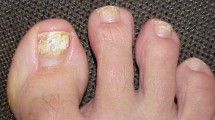Abstract
In order to define the prevalence ofCandida ciferrii in onychomycosis, the fungal biota associated with toe nail onyxis was examined in 50 elderly patients with trophic disorders of the legs and in 220 patients without clinical evidence of trophic disorders.Candida ciferrii was more frequent in the first group of patients since it was recovered from 24% of these patients, whereas its prevalence was only 1.4% in the control group. Moreover, the positivity of the direct examination of toe nail scrapings, the absence of any other associated pathogens, and the repeated isolation of this yeast species for some of the patients confirmed its pathogenicity.
Similar content being viewed by others
Abbreviations
- 5-FC:
-
5-fluorocytosine
- IHEM:
-
Institut d'Hygiène et d'Epidémiologie, Section Mycologie
- YPDA:
-
yeast extract-peptone-dextrose-agar
References
English MP, Atkinson R. Onychomycosis in elderly chiropody patients. Br J Dermatol 1974; 91: 67–72.
Gargeya IB, Pruitt WR, Meyer SA, Ahearn DG.Candida haemulonii from clinical specimens in the USA. J Med Vet Mycol 1991; 29: 335–338.
Pospisil L. The significance ofCandida pulcherrima findings in human clinical specimens. Mycoses 1989; 32: 581–583.
Smith RJ, English MP, Warin RP. The pathogenic status of yeasts infecting ulcerated legs. Br J Dermatol, 1974; 91: 697–698.
de Gentile L, Bouchara JP, Cimon B, Chabasse D.Candida ciferrii: clinical and microbiological features of an emerging pathogen. Mycoses 1991; 34: 125–128.
Hunter PR, Fraser CAM. Application of a numerical index of discriminatory power to a comparison of four physiochemical typing methods forCandida albicans. J Clin Microbiol 1989; 27: 2156–2160.
Casals JB. Tablet sensitivity testing of pathogenic fungi. J Clin Pathol 1979; 32: 719–722.
Kreger-van Rij NJW.Candida ciferrii, a new yeast species. Mycopathol Mycol Appl 1965; 26: 49–52.
Smith MT, van der Walt JP, Johannsen E. The genusStephanoascus gen. nov. (Ascoideaceae). Antonie van Leeuwenhoek 1976; 42: 119–127.
Middelhoven WJ, de Kievit H, Biesbroek AL. Yeast species utilizing uric acid, adenine, n-alkylamines or diamines as sole source of carbon and energy. Antonie van Leeuwenhoek 1985; 51: 289–301.
Klokke AH, Kamp H. Een systematisch onderzoek naar animale mycosen bij vee en mens. Ned Tijdschr Geneesk 1962; 106: 1673–1675.
Furman RM, Ahearn DG.Candida ciferrii andCandida chiropterum isolated from clinical specimens. J Clin Microbiol 1983;18: 1252–1255.
Kombila M, Gomez de Diaz M, de Bievre C, Crepet G, Debrie JC, Belembaogo E, Richard-Lenoble D. Les otites mycosiques à Libreville; étude de 83 cas. Bull Soc Pathol Exot 1989; 82: 201–207.
Author information
Authors and Affiliations
Rights and permissions
About this article
Cite this article
de Gentile, L., Bouchara, JP., Le Clec'h, C. et al. Prevalence ofCandida ciferrii in elderly patients with trophic disorders of the legs. Mycopathologia 131, 99–102 (1995). https://doi.org/10.1007/BF01102886
Received:
Accepted:
Issue Date:
DOI: https://doi.org/10.1007/BF01102886




